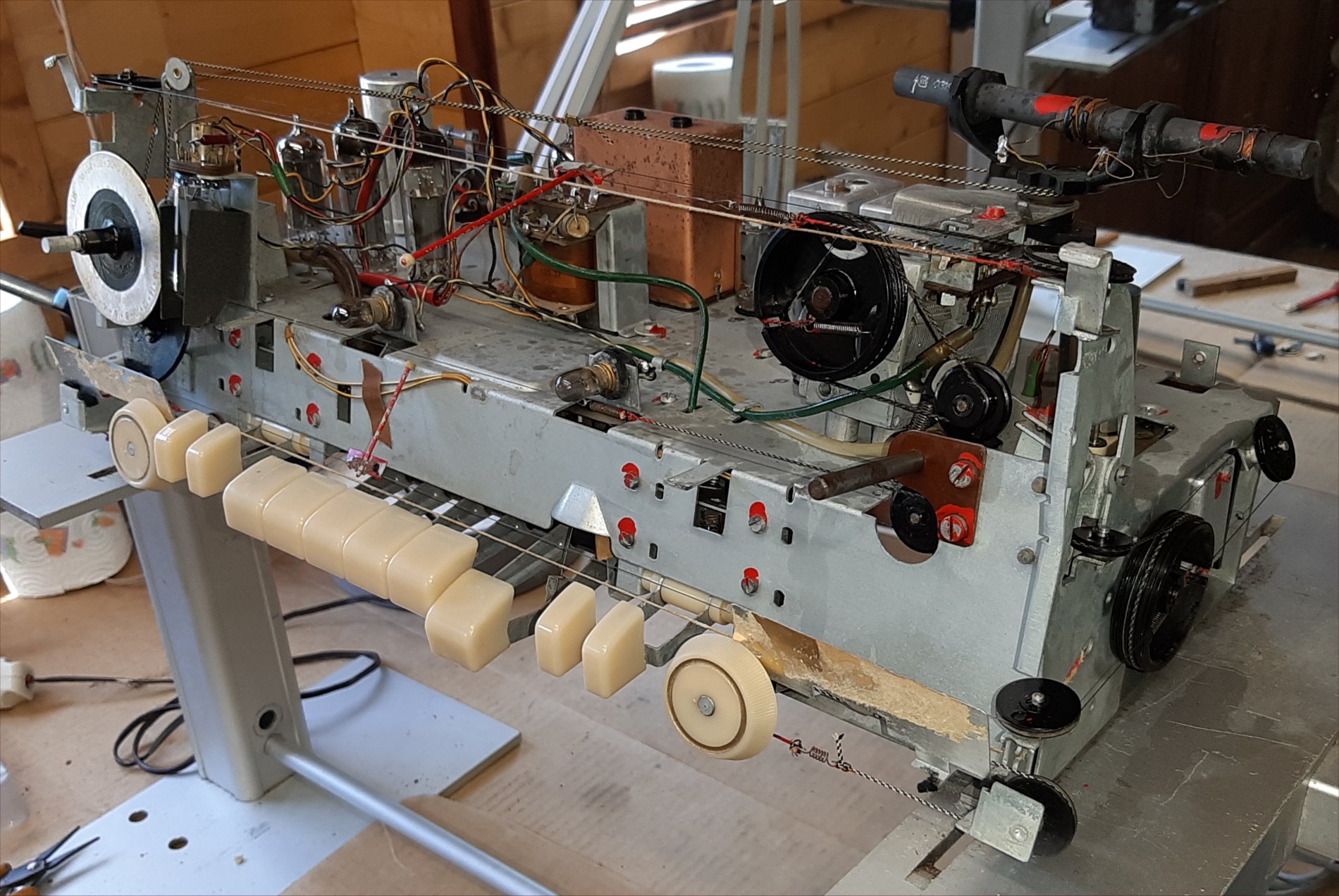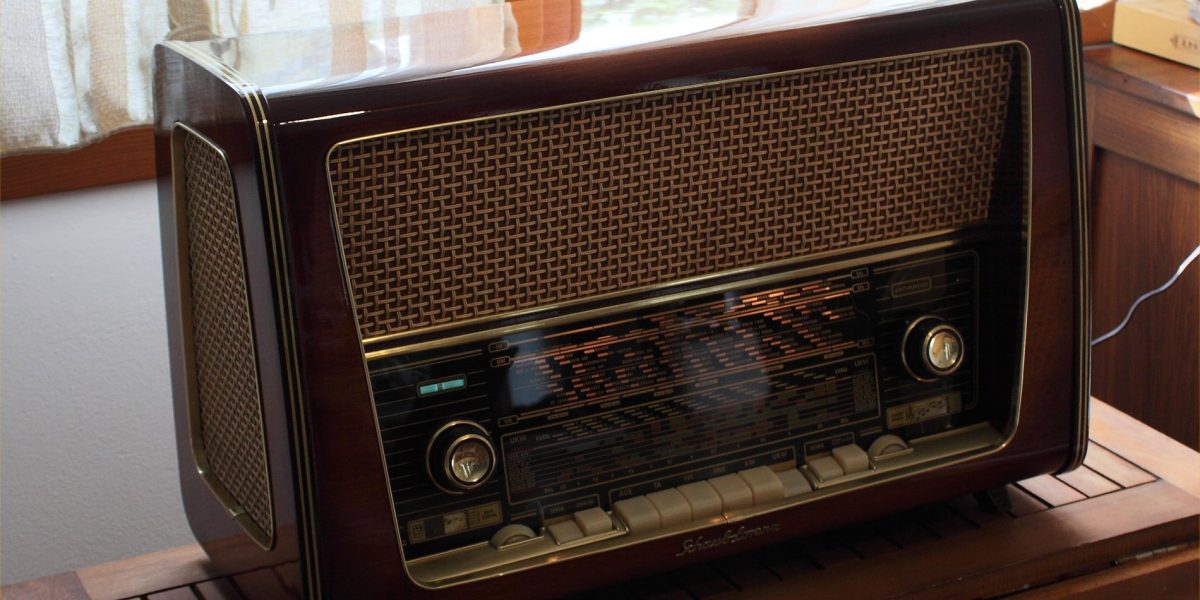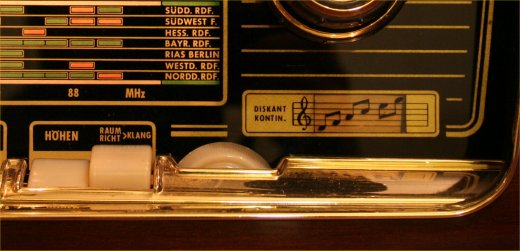 german radios - en
german radios - en
Schaub Lorenz Goldsuper W42 – en
- by giovanni
TRANSLATION BE COMING SOON
SCHAUB LORENZ GOLDSUPER W42
SCHAUB LORENZ GOLDSUPER W42
Come ho scritto in altre recensioni le Schaub-Lorenz si riconoscono alla prima occhiata.
In Schaub gli sforzi dei designer e dei progettisti era orientata all'eleganza degli apparecchi.
La Schaub Lorenz Goldsuper W42 infatti ha una linea snella ed elegante. Le superfici sono mosse, le venature del legno sono simmetriche e scelte con cura.
I fregi, gli ottoni, le tele, sono tutti elementi scelti con gusto per dare un senso di ricercatezza e di classe.
Il colpo d'occhio è quello di un profilo classico ma leggero, ma l'ascolto rivela tutt'altra personalità.
La Goldsuper W42 è il modello top della casa nel 1957.
Uno stadio finale in Push-Pull composto da due Triodo-Pentodo ECL82. Una potenza d'uscita misurata di 6,6 W RMS, superiore a quella dichiarata cautelativamente dalla casa costruttrice.
Due grandi altoparlanti a larga banda anteriori e due tweeter elettrostatici laterali per una potenza di fuoco insospettabile.
Il suono è come di consueto molto morbido, con bei bassi caldi e piacevoli.
La risposta in frequenza è accentuata sulle basse frequenze. Per avere una risposta lineare su tutta la banda il mio consiglio è quello di tenere premuto il tasto Hohen, che esalta la risposta nella parte alta della banda. Questa indicazione è valida soprattutto nell'ascolto di brani, non compressi, da ingresso Bluetooth. In tal modo si potranno realmente apprezzare le caratteristiche di brillantezza dei tweeter elettrostatici e la leggerezza dei coni frontali.
La manopola di sintonia è molto piacevole da utilizzare per via del particolare sistema, a puleggia, di trasmissione del movimento.
I tasti sono morbidi e dall'azionamento sicuro e senza inceppamenti.
La sezione sintonizzatore è stabile ed esente da disturbi.
La scala parlante colorata è molto leggibile, grande ed appariscente, altra caratteristica delle Schaub-Lorenz.
Karl Daniel Lorenz, il padre di Carl Lorenz, era un musicista e compositore di musica da camera.
Per questo il test di questo apparecchio verrà fatto eseguendo brani di questo genere musicale.
La musica da camera comprende qualsiasi tipo di musica scritto per un complesso limitato di esecutori. A seconda del numero degli esecutori a cui è destinata prende il nome di DUO, TRIO, ecc.
La musica da camera strumentale, viene chiamata SONATA, mentre quella vocale viene detta CANTATA. Nella scaletta sono state previste sia Sonate che Cantate.

Cominciamo con la più classica delle sonatine, il primo brano è la Piano Sonata No.16 in C major, K.545 di W.A.Mozart.
In particolare ascoltiamo il primo movimento, l'Allegro. Pubblicata postuma grazie ad una stampa del compositore ed editore J.A. André fu considerata da Mozart una sonata per principianti. Probabilmente deve la sua fama alla semplicità richiesta nell'esecuzione. Essendo molto conosciuta ci permette una facile confronto.
Il secondo brano è una bella incisione del 1999 della Decca. Si tratta della Salve Regina in F minor tratta dallo Stabat Mater di G.B.Pergolesi. Nato a Jesi nel 1710 e morto a soli 26 anni di tubercolosi. Il Pergolesi nutriva una grande venerazione per la Madonna, e lo Stabat Mater fu terminato, con grande tenacia dall'autore proprio pochi giorni prima della sua morte. Lo Stabat Mater, attribuito a Jacopone da Todi, è l'apertura del componimento poetico, inizialmente recitato e poi cantato, nelle celebrazione dedicate alla Vergine Addolorata. La trascrizione del Pergolesi è particolarmente toccante considerando anche il contesto di sofferenza derivante dalla malattia, in cui fu scritta.
Il terzo brano è un recitativo di F.Mendelssohn , il cui titolo è "Da Jesu geboren ward". E' tratto da un compact disk prodotto dell'encomiabile associazione francese Mécénat Musical Société Générale, fondazione dell'omonimo gruppo bancario francese. Il recitativo inizia con "Da Jesus geboren ward zu Bethlehem im jüdischen Lande" che è l'incipit del Vangelo di Matteo 2,1 nella trascrizione di Martin Lutero. L'intero Oratorio è di provenienza Protestante, questo rende l'incisione storicamente molto interessante.
Il quarto brano è di César Franck - Sonata in La maggiore per Violino e Pianoforte. Una curiosità su questa sonata merita di essere conosciuta. Questa sonata fu il regalo di nozze di Franck all'amico e virtuoso belga Eugène Ysaÿe. La prima esecuzione avvenne nel Museo d'Arte Moderna di Bruxelles e programmata per essere eseguita nel pomeriggio. Il regolamento della galleria però stabilisce che non vi debba essere alcun tipo di illuminazione artificiale nelle sale. Alla fine del primo movimento, essendo ormai buio, i presenti vennero invitati ad andarsene dal personale. Ma gli spettatori rifiutarono ed Ysaÿe e la pianista continuarono ad eseguire la Sonata al buio, a memoria, emozionando gli ascoltatori. Arte è anche questo.
L'ultimo brano è il BB115, I. Assai lento - Allegro troppo dalla Sonata for Two Pianos and Percussion di Béla Bartók. Questo brano, pur conservando al forma sonata rappresenta una decisa rottura rispetto ai pezzi proposti in precedenza. Nel primo movimento la struttura ritmica viene enunciata, poi viene modificata per poi essere riproposta. E' una forma abbastanza complessa, anche da ascoltare. La Sonata di Bartok è una delle ultime e più mature opere del compositore. In una delle prossime recensioni invece verrà proposto un pezzo de "Il mandarino meraviglioso", l'opera più tormentata, scandalosa ed ardita del compositore Ungherese.
-
BLUETOOTH
Bluetooth receiver embed
-
PIATTAFORMA MULTICONNESSIONE
Each radio is equipped with a cable for connection to any digital device.
TUBESOUND UPGRADE
- Bluetooth receiver embed - The unit is equipped with a BLUETOOTH receiver powered directly by the receiver power supply. This makes it possible to control the amplifier from any external digital device as an IPAD, a Smartphone, or a sophisticated multimedia station. So you can hear your preferred web station or your lossesless file without cables on the room. Wireless Receiver can be equipped upon requests.
– Multi Platform Connection – A customized adaptation cable to connect any digital device as Iphone, Smartphone, Laptop, CD Player etc. will be provided with this radio. This special cable suits the different impedances between the modern equipment and the receiver. Furthermore the two stereo channels flow into one without increasing the load to the input unit.


HISTORY
In 1870, Carl Lorenz (1844-1889) opens a lightning hardware shop in Berlin.
After his death, the company is acquired by textile entrepreneur Robert Held (1862-1924).
Carl's brother, Alfred Lorenz, is appointed as technical director. Under Held, the company became an important supplier of telegraphy equipment.
The company expands in the telephone industry buying Lewart and it becomes the telephone provider for postal service.
In 1906, the company is registered for public commerce as C. Lorenz AG.
At the beginning of World War I, Lorenz had reached the number of 3.000 employees and was an important provider of telephone and telegraphy equipment for the German army.
At the end of the First War, the size of the company decreases considerably and activities are oriented to the production of household radios and aeronautical communications devices.
In the 1920's, the company is the main competitor of Telefunken.
In 1930, it is under the control of Standard Elektrizitätsgesellschaft, a branch of American society ITT.
Lorenz patented the ferrite aerial in 1935, which has been used since then in most domestic receivers.
While Germany was preparing for another War, Lorenz went back to the production of material for the army.
In 1940, he aquires G. Schaub Apparatebau-Gesellschaft; its many factories were mainly used for low-cost production.
Lorenz's military products during World War II included land and air radars, radios, recorders, radio tubes and the safest communication device in Germany, Lorenz's machine and code.
Lorenz owned the 25% of Focke-Wulf, the German aeronautical company that built some of the most successful Luftwaffe fighter jets.
In the midst of the War, Lorenz had about 24.000 workers in 12 operating structures.
In 1948, Lorenz has to start over.
Some factories had been shut down and those in the eastern part had been transferred or transferred to the Soviet Union.
During the 1950's, Lorenz recovers very quickly. In 1954, the name of the broadcasting devices brand is changed to Schaub-Lorenz.
In 1958, C. Lorenz AG ceased to exist as an independent company. ITT reorganizes its activities in Germany by merging Lorenz, Standard Elektrizitätsgesellschaft and many more into a new society, named Standard Elektrik Lorenz (or SEL).
In 1961, the company also becomes the main shareholder of Graetz.
In 1987, it is incorporated by the French company Alcatel.
In 2016, Alcatel is bought by Nokia.

MAIN FEATURES
Year of production: 1956/57
Superheterodyne IF 468/10700
8 AM Circuits
11 FM Circuits
Wavebands: Medium Waves (OM), Long Waves (OL),Short waves (OC), FM (UKW)
Loudspeakers:
2 main wideband loudspeakers in front
2 Electrostatic Tweeters on sides
Dimensions (LHD):640 x 400 x 270 mm / 25.2 x 15.7 x 10.6 inch
Net weight: 13 kg / 28 lb 10.1 oz
8 Tubes: ECC85 ECH81 EF93 EABC80 EM80 2xECL82 EZ80
LW and MW rotating ferrite antenna embed

CARATTERISTICHE TECNICHE MISURATE
IMPORTANTE PREMESSA
(da leggere con attenzione almeno la prima volta)
- Le misure che seguono sono state eseguite allo scopo di confrontare, dal punto di vista elettrico, gli apparecchi che via via verranno recensiti in questo sito. Non è possibile fare un confronto con le misurazioni effettuate da altri laboratori su altri apparecchi. La strumentazione e le condizioni di misura sono probabilmente molto diversi.
- La strumentazione impiegata per le misurazione è obsoleta e non professionale. Riteniamo non sia necessaria una strumentazione più precisa a causa delle tolleranze del sistema uditivo umano. Distinguere una distorsione dell'1% da una del 1,1% o 1,001% ha senso solo dal punto di vista elettrico. Probabilmente nessuno ad orecchio può sentire la differenza. Solo un bambino e pochissimi fortunati possono percepire la differenza tra una curva di risposta lineare fino a 16 KHz ed una fino a 20 kHz.
- La percezione del suono dipende da molti fattori, l'età dell'ascoltatore, l'ambiente di ascolto, quanto si presta quel genere musicale ad essere riprodotto, le aspettative dell'ascoltatore, la sua abitudine all'ascolto, la sua conoscenza e molti altri fattori, oltre naturalmente alla qualità della catena di riproduzione. Non c'è quindi una relazione diretta ed univoca tra i risultati delle misure effettuate e la piacevolezza d'ascolto di un determinato apparecchio.
BANDA PASSANTE
La Curva della risposta in frequenza è stata rilevata su carico resistivo misurando la tensione efficace alle diverse frequenze e convertendo i risultati in DB
La linea ROSSA indica la banda passante con i potenziometri di tono in posizione di massima esaltazione
La linea BLU indica la banda passante con i potenziometri di tono in posizione lineare.
La banda passante è stata misurata su carico resistivo. Non tiene conto quindi delle deformazioni derivanti dal carico induttivo degli altoparlanti e della risposta meccanica degli stessi.
POTENZA RMS
Consideriamo come Potenza Massima il quadrato della minore tra le tensioni RMS misurate alle tre frequenze campione diviso la resistenza di carico.
Le condizioni di misura sono le seguenti:
- frequenze campione, 100, 1000, 10.000 Hz
- carico resistivo di 4 ohm
- distorsione minore o uguale a 1%.
Lo strumento di misura fornisce direttamente il valore RMS.
La potenza RMS misurata è di 6,6 W
DISTORSIONE DI INTERMODULAZIONE %
La Distorsione di Intermodulazione è stata misurata con lo standard SMPTE e potenza di erogazione misurata di 1W RMS.
Le due misure sono state eseguite modulando l'onda sinusoidale base di 50 Hz con una sinusoide a 5400 Hz, con una ampiezza in rapporto di 1/4 rispetto alla sinusoide di base.
La tensione di uscita è stata mantenuta intorno ai 2,00V su un carico di 4 ohm.
La Distorsione di Intermodulazione (IM%) misurata è di 0,6%
A puro scopo didattico qui di seguito si vede l'effetto di un incremento eccessivo del segnale di ingresso sulla distorsione. La deformazione della forma d'onda in uscita è evidente. Le valvole finali lavorano in zona di non linearità, saturando e producendo una grande quantità di armoniche (nei punti indicati nelle foto).
BANDBREITE SCHALTBAR
The frequency response correction system is made of 4 keys that insert preset equalization curves operating on the feedback circuit, they are not passive filters.
The Basse key emphasizes the bass.
The Sprache key emphasizes the mids for a cleaner listening to broadcasts spoken.
The Hohen key emphasizes the treble.
The 3D/1D excludes the side speakers.

TONE CONTROL WITH LEVEL INDICATION
The tones control system is very efficient.
Above the large tone control knobs there is a band that lights up gradually indicating the emphasis on the band on which it acts.
Max Bass

Flat Bass

Min Bass

Max Treble

Flat Treble

Min Treble

AERIALS
Inside the cabinet there is a dipole for FM reception and a rotating ferrite antenna for AM reception.
The reception sensitivity with internal antennas is very good.
Using an external aerial sensitivity is further increased.

SEPARATE CONTROL TUNING BETWEEN AM AND FM
The tuning system is another gem.
The unit is equipped with mechanisms for keeping separate the AM and FM bands.
The tuning knob is single but a selector switch commutes into cable systems (all in steel) and pulleys separated depending on the band.
The movement is transferred to both mechanisms with a system of pulleys and separated gears.
TUNING INDICATOR
The magic eye has of course been replaced.

CONTROL PANEL

1 - Volume control, with loudness integrated.
2 - Ferrite Antenna rotating control
3 - Ferrite Antenna position indicator
4 - Magical eye indicating the perfect tuning of each station
5 - Bass indicator
6 - Bass control
7 - Bandbreite Schaltbar
8 - OFF
9 - Auxiliary input
10 - Long Wave
11 - Medium Wave
12 - Short Wave
13 - FM
14 - Treble control
15 - Treble indicator
16 - Tuning

REAR SIDE
Output for external speakers.
Socket for recorder (tonbandgerat).
Turntable input (Tonabnehmer)
AM and FM aerial inputs and ground socket.
THE USUAL AMAZING LAST IMAGE






















































































